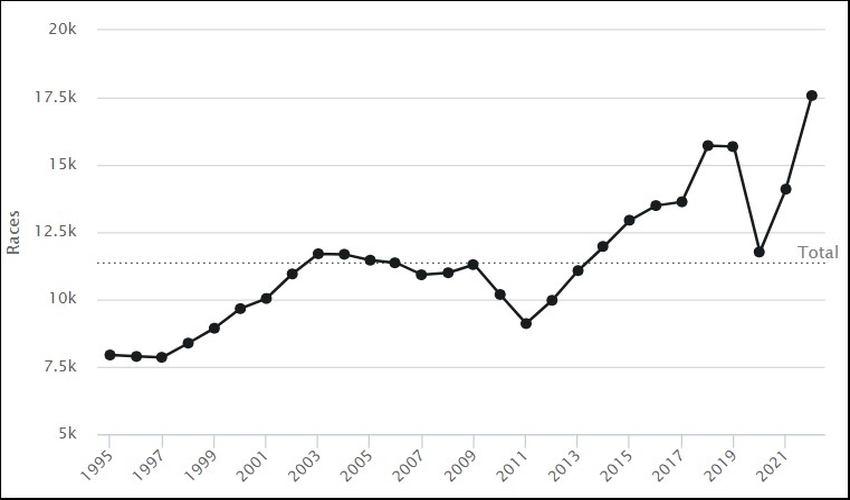 The sport of horse racing is a glorious one, loved by millions in this country and even more globally, but as much as those working in the industry love their jobs, if they weren’t getting paid, then they would be far less inclined to turn up every morning.
The sport of horse racing is a glorious one, loved by millions in this country and even more globally, but as much as those working in the industry love their jobs, if they weren’t getting paid, then they would be far less inclined to turn up every morning.
In order to get paid, these people need to work for stables and trainers who earn enough money to pay them, and in order to earn that sort of money, they need theirs and their client’s horses to win prize money at the races.
Prize money then, in the reason horse racing exists in the first place. It’s similar for punters too really; ok they don’t share prize money, but they bet on the outcome to try and win money from the bookies, so it’s a very similar incentive.
How many of you would watch a horse race with no money on the line? No, nor us.
It’s hard to invest emotionally when there is nothing at stake, so money really is the key to what makes horse racing exciting.
The average purse for racing is an important metric to monitor because it gives some indication as to the health of the industry, and of course, it’s what attracts owners and trainers to enter their horses into races in the first place.
We looked at the number of races with fewer than 6 runners in a different article, and prize money lagging behind that in other big racing countries was one of the reasons smaller fields were on the rise.
It’s also interesting to look at the difference, if any, between the purse size in jump and flat racing, which we will do later on in this article.
How Prize Money Works in Horse Racing
 Before we dive into the stats, it makes sense to bring everyone up to speed on how prize money actually works in horse racing, and where the purse size comes from in the first place.
Before we dive into the stats, it makes sense to bring everyone up to speed on how prize money actually works in horse racing, and where the purse size comes from in the first place.
Each race type will have a minimum purse, but this can grow to be much bigger depending on how popular the race is.
For example, a Grade 1 open chase comes with a minimum prize purse of £150,000 as of 2023, but a famous race of this type such as the Cheltenham Gold Cup would have a much bigger purse in reality.
The Gold Cup had a total purse of £625,000 in 2023, to be split between the 5 top finishers, so much higher than the minimum.
This is because the size of the purse is impacted by a few different factors:
- Bets made on the race (a portion of each bet goes to the prize purse via the levy fund)
- Race sponsorship
- Broadcast revenue
- Entry fees (owners have to pay to enter their horses into the race)
- Entry tickets from spectators
So a race with lots of runners that is on telly, sponsored by a big company, is widely bet on both on course and in bookies up and down the land, and is watched by a heaving crowd at the track, will have a lot more in the kitty than an average 3.15 race at Chester on a rainy Tuesday.
How the Purse is Split
 This brings us on to how the purse is split between the runners in each race.
This brings us on to how the purse is split between the runners in each race.
Runners coming in 1st to 5th will get a portion of the purse in every race, but those finishing lower down can also earn small amounts in certain races, it just depends on how it has been structured.
In terms of how much of the purse the top finishers get, well this is not set in stone either.
Again, it will vary a little race by race, but largely the distribution will be something like this:
- 1st Place – 50% to 60%
- 2nd Place – 20% to 25%
- 3rd Place – 10% to 15%
- 4th Place – 5% to 8%
- 5th Place and below – 1% to 3%
The distribution should fall within those parameters at the majority of races in the UK.
So even a £100k purse wouldn’t pay that much to a horse in 4th or 5th place, but a win or a second place finish could be pretty lucrative.
After this, those chunks of money are split again and distributed something like this:
- Owners – 75%
- Jockey – 10%
- Trainer – 10%
- Stable Staff/Racing Charities – 5%
So if a horse came second and won 20% of the purse, that 20% would become the new 100%, and it would be split as described above.
Therefore, a small race with a £5,000 purse might pay £1,000 for second place, so that £1,000 would be split with the owner receiving £750, the jockey and the trainer getting £100 each, and the remaining £50 going to staff and charities.
This is why the minimums need to be improved upon, because even winning a race valued at £5k, the £2.5kish you would get wouldn’t go very far once it was split up.
Prize Money Averages in Horse Racing
Now you know a little bit about how the prize money is earned before it is won, you will be able to make a little more sense of the information that follows.
You could argue that flat racing is more ‘rewarding’ than jump racing since over the years the average value of the purse for flat racing has been higher.
The only year since records began that this has not been true was 2020, and COVID will have had a lot to do with that so it was an anomaly.
A lot has been done recently to try and boost the purse at races, since their low value was having a detrimental effect on racing as a whole, and you can see the steady progress being made if we go back to 1995.

A few dips in there, usually due to external factors, but on the whole prize money has only been going in one direction – up.
In 1995 the average purse for all races in the UK was £7,936.62, whereas a little under 30 years later in 2022, the average was £17,574,35 – that’s a jump of over 121%.
Now obviously, a lot of time has passed since 1995 and inflation has done its thing, so of course purses will be much higher now.
Comparatively, house prices went up 424% in the same period, while a loaf of bread went up 110%, and everyone’s favourite inflation metric, the Freddo, went from 10p to 25p in that time, a rise of 150%.
This semi-serious comparison very crudely shows that actually, while the purse for races might have gone up numerically, in real terms, it’s pretty much in the same place.
But what do we find if we look at the difference between flat racing and jump racing purses?
Average Purse Size for Jump Races

The data tells us that the average prize purse for jump races in 2022 hit an all-time high of £15,689.85 per race.
Of course, this is not the actual size of the purse at each race, and the disparity between the bog-standard weekday races and those known as prestige races will be huge.
Still, the fact that it is higher than ever before is encouraging – at least it is heading in the right direction – and especially when you learn that this represents more than a 28% increase on the average of £12,181.53 the year before.
That is certainly an inflation beating figure.
Still, a large part of this will come from the big races that pull in a lot of money; you can see the difference between the minimum purse that must be offered in the various different jump categories below:
| Grade/Class | Type | Open/Novice | 2023 Minimum Purse |
|---|---|---|---|
| Grade 1 | Chase | Open | £150,000 |
| Grade 1 | Chase | Novice | £80,000 |
| Grade 1 | Hurdle | Open | £100,000 |
| Grade 1 | Hurdle | Novice | £60,000 |
| Grade 2 | Chase | Open | £60,000 |
| Grade 2 | Chase | Novice | £40,000 |
| Grade 2 | Hurdle | Open | £50,000 |
| Grade 2 | Hurdle | Novice | £30,000 |
| Class 2 handicaps w/rating band | Chase | N/A | £22,500 |
| Class 2 handicaps w/rating band | Hurdle | N/A | £18,500 |
| Class 3 handicap | Chase | N/A | £11,500 |
| Class 4 handicap | Chase | N/A | £7,300 |
| Class 5 handicap | Chase | N/A | £5,300 |
| Class 3 handicap | Hurdle | N/A | £9,800 |
| Class 4 handicap | Hurdle | N/A | £6,500 |
| Class 5 handicap | Hurdle | N/A | £5,000 |
Needless to say, there are far more lower-class races than those big Grade 1s.
It’s not all the big races boosting the overall figures though; the number of races held per year has been purposefully reduced of the last few seasons, specifically to help improve field size and the value of the purse.
This has obviously worked, especially in jump racing which was suffering the most with small field sizes.
However, the gap between jump purses and flat purses is about the same as it ever was.
Average Purse Size for Flat Races

Much of what was said in the section about jump races is also relevant here, such as the changes to the number of races being held and the prestige races accounting for a large proportion of the overall averages.
If anything, flat racing is even more heavily influenced by the big races when it comes to overall average prize purses, because there a more top-class races in this category and the minimum purse is generally higher too, as you can see below:
| Class | 2023 Minimum Purse |
|---|---|
| Group 1 – 2yo | £200,000 |
| Group 1 – 3yo+ | £250,000 |
| Group 2 – 2yo | £80,000 |
| Group 2 – 3yo+ | £100,000 |
| 2 Handicaps – 3yo+ | £25,000 |
| 2 Handicaps – 2yo | £18,000 |
| 3 Handicaps – 3yo+ | £15,000 |
| 3 Handicaps – 2yo | £13,000 |
| 4 Handicaps – 3yo+ | £8,750 |
| 4 Handicaps – 2yo | £7,600 |
| 5 Handicaps – all | £6,000 |
| 6 Handicaps – all | £5,000 |
Flat racing has enjoyed a big jump in the value of prize purses too, although the average purse has not increased as much as jump racing on percentage.
In 2021 the average purse for flat racing was £15,219.25, rising to £18,727.41 in 2022, which is an increase of 23% – so around 5% less dramatic than that of jump racing, but inflation beating nevertheless.
With the new minimums in effect from 2023 onwards, both disciplines should see those amounts rise higher too.
However, in order for prizes to be higher in real terms, those inflation beating jumps in purse value will need to continue for a few years, otherwise we will just be treading water.
